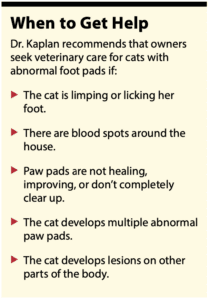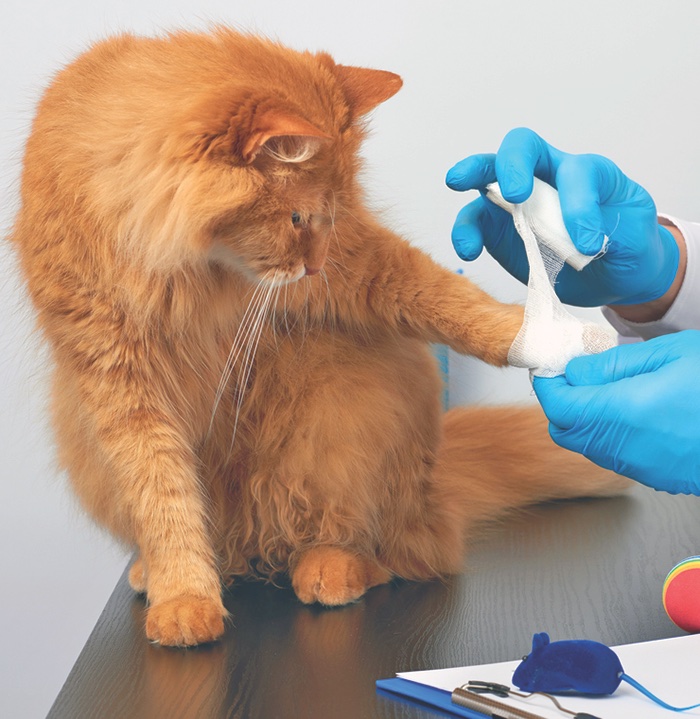Although some feline paw pad problems may resolve on their own, when your cat’s paw pads become injured or appear abnormal, she should see her veterinarian promptly.
The first sign that your cat has a paw pad problem will often be limping or decreased activity. Ingrown claws, burns, and swollen feet are all uncomfortable. When examining your cat’s paws, be cautious. Touching a painful paw may cause even the sweetest cat to bite.
Common Paw Problems
The most common paw pad problem might surprise you. “Ingrown claws are probably the one I see the most,” says Leni K. Kaplan, MS, DVM, senior lecturer at Cornell University’s College of Veterinary Medicine. “This condition is very common in older/senior cats who are not as successful at maintaining claw health on their own.”
Normally, cats keep their claws worn down through regular scratching. Scratching scrapes off excess layers of keratin so that the claws stay short and strong.
But as our cats age and develop osteoarthritis or other health conditions, they may not be able to move around as easily. If your cat isn’t wearing her claws down on her own, they continue growing, and that curved claw can curl all the way around into her paw pad.
An ingrown claw is painful. These wounds are also prone to infections and can become clogged with litter and other debris.
You can prevent ingrown claws by trimming your cat’s nails on a regular basis. This can be helpful to limit nuisance scratching with all cats but is essential for ill or senior cats who can no longer wear their claws down on their own.
If your cat has one or more ingrown nails, the nail(s) will need to be trimmed and removed. Your veterinarian will gently clean the wound with an antiseptic, and may prescribe antibiotics if there is an infection present.
Burns
“Burns happen to the paw pads when cats jump on a hot stove or fireplace or similar hot area,” says Dr. Kaplan.
Your cat won’t necessarily know that an item or surface is hot until she touches it, and then it may be too late. Be mindful about any hot surfaces or items and how they overlap with areas on which your cat commonly walks. Food smells may entice your cat to step onto a hot stove even if she normally steers clear of that area.

Hot wax burners and glue guns are some other items that can cause paw burns. The worst part about these is that the hot liquid or gel may stick to your cat, resulting in more severe burns until it finally cools or is removed.
In some cases, cats can get chemical burns on the foot pads if they walk in caustic substances. Many owners are surprised to find out, for example, that wet concrete can be caustic, and cats can get chemical burns on the foot pads if they walk in it.
Treatment will vary depending on the severity of the burn. Mild burns may be allowed to heal on their own, while more severe burns may require bandaging, pain medications, antibiotics to prevent infection, and intravenous fluids to counteract dehydration. The damaged tissue may die and slough off.
Pillow Foot
“There are also paw pad tumors such as plasma cell pododermatitis, which is more commonly known as ‘pillow foot’ in cats,” says Dr. Kaplan. This is a bizarre condition in which plasma cells (part of the immune system) flood into the cat’s paws, resulting in dramatic inflammation and swelling. The paws literally balloon up, so affected cats can look like they are wearing fluffy slippers. The paw pads may crack and become ulcerated.
We don’t know exactly what causes this condition. It is likely an immune system problem, and may also be linked to feline immunodeficiency virus (FIV). In most cases, multiple paws are affected.
Three of the more common medications used for pillow foot are doxycycline, prednisolone, and cyclosporine. For large and painful or ulcerated swellings, surgery may be necessary.
Bandage Care
Depending on the type and severity of your cat’s paw injury, she may require one or more bandages. Bandages need to be kept clean and dry to promote healing, which means regular bandage changes.
“My preference is to have the cat rechecked by their veterinarian to replace or change a bandage,” says Dr. Kaplan. Your cat’s veterinary care team is able to do it quickly and safely.
“If you change the bandage at home, make sure to unravel the bandage to remove it versus using scissors to cut it off, ” says Dr. Kaplan. “When replacing the bandage, it is crucial to make sure it is not too tight, as this could affect circulation and could cause a different set of serious problems.”




